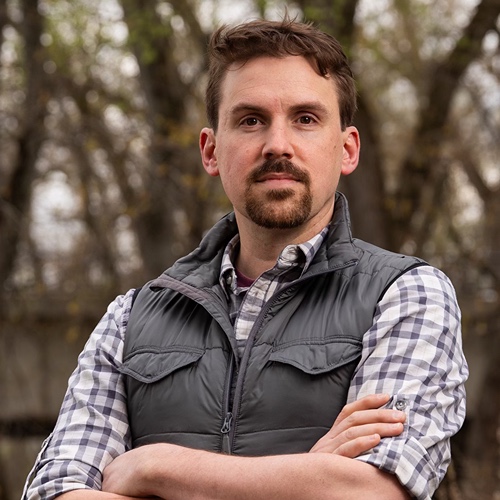Five research centers and four long-term research projects are housed within the Purdue Department of Forestry and Natural Resources. This edition of the FNR Year in Review 2022 will cover the happenings and research of those centers and projects.
Center for Digital Forestry
- Director: Songlin Fei, Dean’s Chair for Remote Sensing
- Purdue’s Center for Digital Forestry is transforming the future of our forests by developing digital technology and new strategies to better manage our forests.
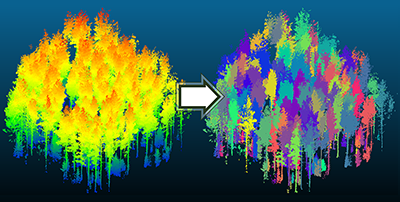
Digital Forestry faculty members have contributed to more than 100 publications in the past year.
The Spring Student Symposium featured presentations by more than 40 graduate students representing approximately $2 million in research support for students, staff and postdoctoral researchers in Digital Forestry.
Through integration of aerial and ground-based mobile mapping sensors and systems, a team of Purdue digital forestry researchers has used advanced technology to locate, count and measure over a thousand trees in a matter of hours. Learn more:Integration leads to leap in tech for forest inventory, management.
Purdue University has received $12 million of a $35 million project led by the American Forest Foundation and funded by the U.S. Department of Agriculture’s Partnership for Climate Smart Commodities to help family forest owners practice climate-smart forestry in Indiana and eight other states across the eastern United States.
Purdue University and the U.S. Forest Service announced the new and improved Alien Forest Pest Explorer interactive web tool, a user-friendly dashboard which combines information from multiple sources to show the impact of different forest insects and diseases, and the potential for further damage.
How lightning travels from the sky to the ground inspired the concept behind a new algorithmic approach to digitally separate individual trees from their forests in automatic forest mapping. Learn more: Purdue team introduces advance in automatic forest mapping technology.
Beyond offering cooling shade, research shows trees can influence microclimates and help reduce the toll of heat waves on the electrical grid and human health. However, the specifics of how trees influence urban areas and the magic number needed for significant heat benefits remains unknown. Learn more: Throwing shade: A.I. project a breakthrough in urban forestry.
Current Projects include:
- Promoting Economic Resilience and Sustainability of the Eastern U.S. Forests (PERSEUS)
- Tree Inventory with Aerial Remote Sensing
- Stress Epidemiology
- Automated Tree Inventory with Photogrammetry
- Precision Management
- Tree Health and Quality Assessment with LiDAR
- UAS Disturbance Detection
- Terrestrial Mobile LiDAR for High Resolution Forest Inventory
- Wood and Bark ID
- Urban Forest Inventory Using Artificial Intelligence
CENTER FOR GLOBAL SOUNDSCAPES
- Director: Dr. Bryan Pijanowski
- The Discovery Park Center for Global Soundscape's mission is to support discovery, learning and engagement activities that lead to the preservation of the Earth's natural acoustic heritage.
Drs. Bryan Pijanowski and Jingjing Liang were awarded funding from NASA for their 3-year project using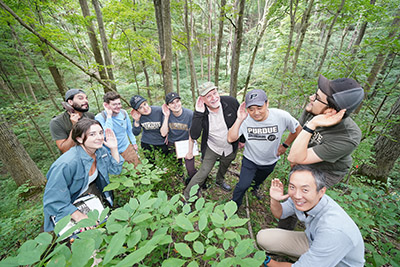 bioacoustic and space-based sensors to develop a large biodiversity framework. The research team’s work in some wild and remote places around the globe, from Tanzania’s Miombo Woodlands, Mongolia’s savanna and forest-steppe ecosystems, and the mangroves of the Sundarbans UNESCO World Heritage Site in Bangladesh, was featured in the story “Assessing Global Biodiversity with Ears to the Ground, NASA Eyes in the Sky.”
bioacoustic and space-based sensors to develop a large biodiversity framework. The research team’s work in some wild and remote places around the globe, from Tanzania’s Miombo Woodlands, Mongolia’s savanna and forest-steppe ecosystems, and the mangroves of the Sundarbans UNESCO World Heritage Site in Bangladesh, was featured in the story “Assessing Global Biodiversity with Ears to the Ground, NASA Eyes in the Sky.”
Dr. Pijanowski spoke on biodiversity and soundscapes at Think Corner Helsinki. His talk titled “The current biodiversity crisis needs creative solutions” was given in person at the Think Corner at the University of Helsinki in Finland on April 26 and livestreamed to a global audience.
The work that Dr. Bryan Pijanowski and members of his lab at the Center for Global Soundscapes are doing studying sound in Mongolia and how it affects the practices of local herders was featured in this MNB World News story beginning at the 2:42 mark.
Pijanowski was part of the Canadian Geographic article “Bioacoustics: What Nature’s Sounds Can Tell Us About the Health of Our World.”
PhD student Sam Lima spent the summer in Mongolia conducting research on soundscapes and the sonic practices of traditional herders in remote rural locations of the Arkhangai Province, alongside fellow PhD student Francisco Rivas Fuenzalida and Dr. Bryan Pijanowski.
PhD student Francisco “Fran” Rivas Fuenzalida spent the summer in Mongolia conducting research on soundscapes and the sonic practices of traditional herders in remote rural locations of the Arkhangai Province.
Hardwood Ecosystem Experiment
- Researcher/Interim Project Coordinator: Dr. Mike Saunders
- Interim Field Coordinator: Rae Garrett (as of May 1, 2023)
- As populations of some forest organisms decline, restrictions on landowners may increase because species become classified as endangered or threatened (e.g., the Indiana bat), while increasing populations of other species (white-tailed deer, invasive plants) create economic and ecological challenges. To address these issues, the HEE, a long-term, large-scale experimental study of forest management and its impacts, was initiated in 2006.
Members of the HEE staff spoke with participants from the Indiana Natural Resources Teachers’ Institute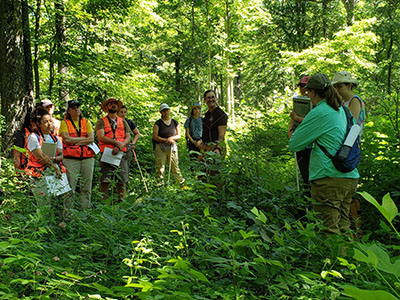 (NRTI) over the summer. NRTI is coordinated by Project Learning Tree, Purdue FNR Extension, and the Indiana DNR. As part of the program, participants learn about forest ecology and management and get tools and skills for teaching their students about forestry in Indiana. For the HEE portion of the NRTI, the educators heard from HEE staff, several graduate students, and technicians about a number of the ongoing studies at the HEE.
(NRTI) over the summer. NRTI is coordinated by Project Learning Tree, Purdue FNR Extension, and the Indiana DNR. As part of the program, participants learn about forest ecology and management and get tools and skills for teaching their students about forestry in Indiana. For the HEE portion of the NRTI, the educators heard from HEE staff, several graduate students, and technicians about a number of the ongoing studies at the HEE.
The HEE looks forward to its involvement in a new initiative called Let the Sunshine IN (Indiana), which has received funding from a USDA Forest Service landscape scale restoration competitive grant. The initiative led by the American Bird Conservancy will work with partners across Indiana, including the HEE, to maintain and restore the oak-hickory ecosystem in southern Indiana through education, outreach and implementation.
The HEE welcomed three new graduate students to its research cohort. Sarah Baker joined the team as a Purdue PhD student who will be investigating the impact of forest management strategies on squirrel populations under Drs. Elizabeth Flaherty, Rob Swihart and Pat Zollner. Brit Nahorney is a master’s student in Dr. Kamal Islam’s lab at Ball State University who will be studying the diet composition and prey selection of adult cerulean warblers. Julian Grudens also is a master’s student in Dr. Islam’s lab, who will be studying cerulean warblers at the HEE for his thesis.
Lizz Beilke successfully defended her doctoral dissertation on “The Tropic Ecology of Insectivorous Bats in the Eastern United States and their Ecological Impact to Forests” and earned her PhD from Indiana State University. Lara Jones received her master’s degree from Ball State after defending her thesis on “Long-distance dispersal patterns and carry-over effects in the Cerulean Warbler (Setophaga cerulea) in southern Indiana” under Dr. Kamal Islam. Bethan Darby also complete her master’s degree from Ball State under Dr. Islam after defending her thesis on “Spatial distribution of Cerulean Warbler nests and landscape-level nest associations and Cerulean Warbler response to silvicultural treatments.”
The HEE said goodbye to Danielle Williams, its field coordinator since Feb. 2020. Williams will be a central region ecologist with the Indiana Department of Natural Resources Division of Nature Preserves.
HEE Project Coordinator Charlotte Owings left her role with the HEE after seven years, accepting the position of alumni, scholarship, awards and student career specialist for Purdue FNR.
Media
- Dr. Lizz Beilke talked about bats and her research on the HEE studying how bats can help protect
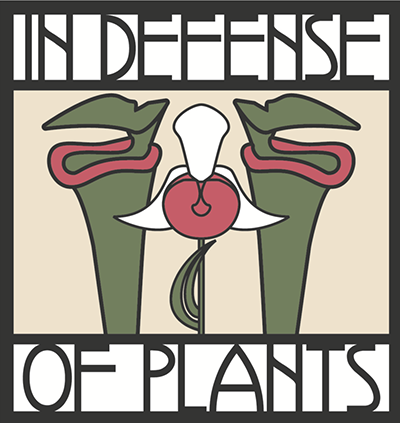 young trees from insect damage on the In Defense of Plants podcast episode 401 – Seeing the Forest for its Bats, released Dec. 25, 2022.
young trees from insect damage on the In Defense of Plants podcast episode 401 – Seeing the Forest for its Bats, released Dec. 25, 2022. - Dr. Kamal Islam from Ball State, who does research on the HEE, talked about his work with cerulean warblers, his findings on the HEE and the importance of forest management to help this state-endangered species in a video by the Natural Conservancy in Indiana as part of the Forestry for the Birds Project.
Publications
- Bats reduce insect density and defoliation in temperate forests: An exclusion experiment. E. Beilke and J.M. O’Keefe in Ecology, 2022.
- Prey size is more representative than prey taxa when measuring dietary overlap in sympatric forest bats. T.J. Divoll, V.A. Brown, G.F. McCracken and J.M. O’Keefe in Environmental DNA, 2022.
- Response of terrestrial salamanders to the decade following timber harvest in hardwood forests. Allison Ochs, Mike Saunders and Rob Swihart in Forest Ecology and Management, 511, 120159.
- Failure to advance migratory phenology in response to climate change may pose a significant threat to a declining Nearctic-Neotropical songbird. B. Connare and K. Islam in International Journal of Biometeorology, 2022.
Hardwood Tree Improvement and Regeneration Center (HTIRC)
- Director: Matt Ginzel
- Spring 2023 Newsletter
- The mission of the HTIRC is to advance the science and application of tree improvement,
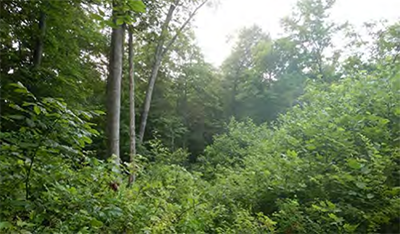 management, and protection of hardwood forests, with emphasis in the Central Hardwood Forest Region. Over the past year, the HTIRC continue to deliver on its mission by advancing the research, teaching and extension priorities outlined in our current strategic plan. Through our project-based funding model, we supported 18 projects in 2022, including two new projects that were selected for funding by our executive committee. These key research projects directly serve our strategic research objectives and also reflect our commitment to serving the needs of our stakeholders.
management, and protection of hardwood forests, with emphasis in the Central Hardwood Forest Region. Over the past year, the HTIRC continue to deliver on its mission by advancing the research, teaching and extension priorities outlined in our current strategic plan. Through our project-based funding model, we supported 18 projects in 2022, including two new projects that were selected for funding by our executive committee. These key research projects directly serve our strategic research objectives and also reflect our commitment to serving the needs of our stakeholders.
A special thanks goes to the HTIRC Executive committee for their vision and continued leadership. The current membership of the HTIRC Executive Committee is:
- John Brown (Pike Lumber)
- Dan Dey (US Forest Service)
- Dana Nelson (US Forest Service)
- Guillermo Pardillo (ArborAmerica)
- Jack Siefert (Indiana DNR)
2022 Highlights
- Published 2022 Annual Report (Link to Come)
- The Indiana Forest Product Price Report is returning thanks to Purdue FNR’s Dr. Mo Zhou. The report has been published since 1934 and past issues have been digitized and explained by Zhou online. Zhou will be reviving the report, which ceased publication in 2021, beginning in 2023.
- We continued our involvement with the Center for Advanced Forestry Systems. In 2009, the HTIRC along with Oregon State University co-founded the only forestry-based National Science Foundation (NSF) Industry/University Cooperative Research Center (I/UCRC). The goal of CAFS is to address challenges facing the wood products industry, landowners and managers of the nation’s forestland. We are now in the third and final phase of CAFS which continues our involvement through 2024
- The HTIRC is part of the Integrated Digital Forestry Initiative, which has received a $12 million grant led by the American Forest Foundation to help family forest owners practice climate-smart forestry in Indiana and eight other states across the eastern United States.
- Purdue University and the U.S. Forest Service announced the new and improved Alien Forest Pest
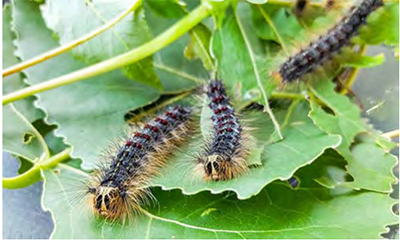 Explorer interactive web tool, a user-friendly dashboard which combines information from multiple sources to show the impact of different forest insects and diseases, and the potential for further damage.
Explorer interactive web tool, a user-friendly dashboard which combines information from multiple sources to show the impact of different forest insects and diseases, and the potential for further damage. - We bid farewell to Wes Schempf, HTIRC Research and Communications Coordinator, as he moved on to the Texas A&M Improvement Program
- Administrative assistant Janis Gosewehr retired after 33 years at Purdue and 22 years working for the HTIRC.
Research Projects Supported in 2022 (Title and PI)
- Characterize abiotic and biotic stress using hyperspectral information – Dr. John Couture
- Tree inventory with aerial remote sensing – Dr. Songlin Fei
- Using terrestrial laser scanning to assess tree health and quality – Dr. Brady Hardiman
- Productivity-diversity relationships in hardwood plantations – Dr. Doug Jacobs
- Understanding and manipulating plant-soil feedbacks to manage the invasive shrub Lonicera maackii –Dr. Mike Jenkins
- Improving establishment practices of pure and mixed hardwood plantations by refining soil suitability indices for black walnut – Dr. Shaneka Lawson
- Natural and artificial regeneration growth response of white oak across light and understory competition gradients – Dr. Mike Saunders
- Using remote sensing to characterize stress epidemiology in hardwood forest stands – Couture
- Geo-referenced and image-assisted in-situ biometric evaluation tool for precision growth and yield modeling – Dr. Rado Gazo
- Precise quantification of forest disturbances with UAS – Dr. Joseph Hupy
- Improve management strategies and techniques to enhance the ecological sustainability and
 economic benefits of hardwood forests – Dr. Mo Zhou
economic benefits of hardwood forests – Dr. Mo Zhou - A New, Faster, Cheaper, and Easier Way to Measure HTIRC Plantations – Dr. Guofan Shao
- Backpack System for High Resolution Forest Inventory- Dr. Ayman Habib
- Testing efficacy of underplanting and enrichment plantings for stand regeneration in hardwood forests – Jacobs
- Indiana’s Future Forests: Emptied Niche Occupation in an Ash-less World – Saunders
- Better Black Walnut By “Breeding Without Breeding” – Dr. Keith Woeste
Projects funded in 2022
- eForester: AI-assisted smartphone app for automated tree inventory – Zhang
- Integrating morphological, genotype, and chemotype based methods to support HTIRC butternut conservation and resistance breeding – Jacobs
Research Publications
- An Unsupervised Canopy-to-Root Pathing (UCRP) Tree Segmentation Algorithm for Automatic Forest Mapping. Carpenter, J., Jung, J., Oh, S., Brady Hardiman and Songlin Fei in Remote Sensing. 2022, 14, 4274.
- An Unsupervised Canopy-to-Root Pathing (UCRP) Tree Segmentation Algorithm for Automatic Forest Mapping. Carpenter, J. et al. 2022. Remote Sensing. 14(17), 4274.
- Automated inventory of broadleaf tree plantations with UAS imagery. Aishwarya Chandrasekaran, Guofan Shao and Songlin Fei in Remote Sensing 2022, 14(8), 1931.
- Comparative Analysis of Multi-Platform, Multi-Resolution, Multi-Temporal LiDAR Data for Forest Inventory. Lin, Y.-C., Jinyuan Shao, Shin, S.-Y., Saka, Z., Joseph, M., Manish, R., Songlin Fei., Habib, A, in a special issue of Remote Sensing: Recent Advancement in High Resolution Remote Sensing for Precision Forestry, 2022, 14 (3), 649.
- Precise Quantification of Land Cover before and after Planned Disturbance Events with UAS-Derived Imagery. Miller, Z.; Hupy, J.; Hubbard, S.; Guofan Shao (2022). Drones 6, 52.
- Preferential allocation of carbohydrate reserves belowground supports disturbance- based management of American chestnut (Castanea dentata). Madeline Montague, Landhäusser SM, McNickle GG, Doug Jacobs. 2022. Forest Ecology and Management 509:120078
- Canopy height model generation and validation using USGS 3DEP LiDAR data in Indiana, USA. Sungchan Oh, J. Jung, Guofan Shao, G. Shao, J. Gallion, and Songlin Fei in Remote Sensing. 2022, 14 (4), 935.
- Managing thousand cankers disease in high-value plantings of black walnut (Fagales: Juglandaceae) in Washington state. CJ Smallwood, MW Ethington, Matt Ginzel in Journal of Integrated Pest Management, 2022, 13(1), 5.
- Forest and Plantation Soil Microbiomes Differ in Their Capacity to Suppress Feedback Between Geosmithia morbida and Rhizosphere Pathogens of Juglans nigra Seedlings. Geoffrey Williams and Matt Ginzel in Phytobiomes Journal, 2022, PBIOMES–02.
- Comparative Evaluation of a Newly Developed Trunk-Based Tree Detection/Localization Strategy on Leaf-Off LiDAR Point Clouds with Varying Characteristics. Zhou, T.; dos Santos, R. C.; Liu, J.; Lin, Y.C.; Fei, W. C.; Songlin Fei, and Habib, A. in Remote Sensing 2022, 14 (15), 3738.
- Forest Feature-based LiDAR SLAM (F2-SLAM) for Backpack Systems. Zhou, T.; Songlin Fei and Habib., A.; 2022. Manuscript is finalized for submission the Remote Sensing of Environment Journal.
Education
We continued to support graduate students through our project-based funding model. Last year the Fred M. van Eck Forestry Foundation for Purdue University funds were used to support nine HTIRC MS students, nine PhD students, five post-docs, six undergraduate research technicians and one high school student over the summer.
2022 Graduates
- Aziz Ebrahimi (Tehran, Iran), PhD; Dissertation: “Morpho-Physiological & Genomics Analyses Underlying Adaptations of Hardwood Trees to Abiotic Stressors”; current position: Postdoc at Purdue University (FNR)
- Sarah Rademacher (Minneapolis, MN), MS Thesis: “Understory response to shelterwood and burn treatments in a dry Quercus forest in Indiana”
Extension Projects
We remain committed to connecting our partners, collaborators, and stakeholders with the people, information, and products of the center through our technology-transfer efforts.
- In 2022 we produced or updated a variety of online resources, including videos on hardwood
management, invasive species, and tree identification These are posted at
https://htirc.org/resources/landowner-information/ and https://www.purdue.edu/fnr/extension/
and include: - ID That Tree series: Over 90 videos highlighting native and invasive trees and shrubs, 8229 views in 2022.

- Woodland Management Moment series: This series covers various woodland
management topics in short video messages to landowners, 1829 views in 2022. - Woodland Stewardship for Landowners video series: Videos from this collaborative
10 video series between Purdue FNR and the Indiana Department of Natural Resources address management issues relevant to woodland owners, 3905 views in 2 - The Planting and Care of Fine Hardwood Seedlings publications provide practical information to landowners and managers for the establishment and management of hardwood trees in plantations and native forests. These publications are utilized by landowners and resource managers.
- Recently posted: Conservation Tree Planting Webinar covering the steps to success for conservation tree plantings.
- Songlin Fei, in collaboration with several partners, launched the Alien Forest PestExplorer interactive web tool.
- The Digital Forestry Initiative has a data portal providing access to existing and new remote sensing data.
- Webinar on Tree-of-Heaven Identification and Management with EAB University, 280 views in 2022.
- Mo Zhou has developed a website with hardwood timber price trends for Indiana.
- Perceptions of Land Managers Towards Using Hybrid and Genetically Modified Trees – by Andrea Brennan, Zhao Ma and Doug Jacobs. Published in New Forests, Nov. 26, 2021. An online survey was administered to land managers in Indiana to gauge perceptions to hybrid and GM trees, and current hybrid tree use. Land managers had stronger concern for ecological, rather than economic, issues, with potential for invasiveness being strongest
New Publications coming soon in 2023:
- Understanding White-Tailed Deer and Their Impact on Indiana Woodlands
- Managing White-Tailed Deer Impacts on Indiana Woodlands - Publications in a series from the Deer Impact Toolbox, which is part of the Integrated Deer Management Project at Purdue University.
Engagement Programs
These programs shared the latest HTIRC information to landowners and/or natural resources
professionals in a mix of online and in-person formats:
- Landowner’s Conservation Tree Planting Workshops
- Forest Management for the Private Woodland Owner courses
- Walnut Council Field Days
- Forest Pesticide Applicators Continuing Education Program
- Tree Farm/IFWOA Landowners Field Days
- Timber Sales 101 workshop
- Invasive Species field days and presentations
- Presentations at the Walnut Council annual meeting
- Presentation for Illinois Beginning Forest Landowners education program
- Presentations at Green Industry continuing education programs
- Hoosier Hardwood Festival education programs
Illinois-Indiana Sea Grant
- Director: Tomas Höök
- With climate change upon us—as well as a host of other concerns such as population growth, aquatic invasive species, contaminated waters, and loss of natural habitat—the southern Lake Michigan region faces many challenges. Illinois-Indiana Sea Grant (IISG), with its unique mandate to bring the latest science to those who can best use the information, serves a critical role in empowering people to solve problems in sustainable ways.
- Director’s Blog – March 2022
- The Helm Magazine – 2022 Issue
- Website: https://iiseagrant.org/
Illinois-Indiana Sea Grant (IISG) celebrated its 40th anniversary by sharing what projects and initiatives are under way and what is being planned for the future.
Illinois-Indiana Sea Grant was honored as a 2022 Weather-Ready Nation Ambassador of Excellence by the National Weather Service for serving as a leader and making significant contributions to building weather-resilient communities. There were 58 ambassadors this year, and IISG was the only Sea Grant program on the list.
Illinois-Indiana Sea Grant introduced a new weather buoy near Chicago, affectionately called Chuoy. It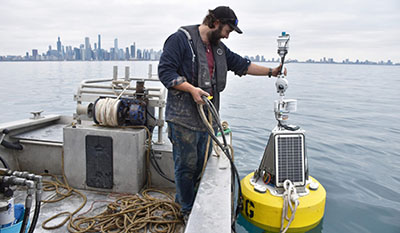 provides live monitoring of weather and water conditions and is also being used in a Sea-Grant funded study to assess changes in southern Lake Michigan water levels and wave conditions and potential impacts for shoreline management. The IISG buoys were also featured in a New York Times article about a winter storm.
provides live monitoring of weather and water conditions and is also being used in a Sea-Grant funded study to assess changes in southern Lake Michigan water levels and wave conditions and potential impacts for shoreline management. The IISG buoys were also featured in a New York Times article about a winter storm.
Many Great Lakes communities that have carried the burden of legacy pollution for decades have a chance for a new lease on life when local waterways are finally cleaned up. A new video series features five cities along waterways deemed Areas of Concern.
The IISG Pollution Prevention Team organized the annual Emerging Contaminants in the Environment Conference (ECEC), which brings together scientists, educators, agency and industry personnel as well as other interested parties for presentations and discussions focused on all aspects of emerging contaminants, such as PFAS and microplastics, in the environment. View and download the 2022 ECEC presentations and watch the keynote speeches.
The Aquaculture Marketing Webinar series, which informs farmers about marketing trends and strategies, current research, best practices and opportunities, was released by the IISG Aquaculture Team.
The Cooperative Science and Monitoring Initiative Team discussed successes and lessons learned from their ongoing efforts in the Great Lakes at the Joint Aquatic Sciences meeting in May.
IISG redesigned and enhanced its Lake Michigan Water Safety website to include safety tips for swimming, boating and fishing both before heading out on the water and while on or in the water. The site also includes on-the-ground and online resources for beach managers and other looking to raise awareness and provide safety tips.
Illinois-Indiana Sea Grant completed its portion of a multi-state funded project to support stormwater management through green infrastructure activities at a very local level through a project called One Block at a Time.
IISG personnel helped nine Indiana high school teachers engage their students in a unique STEM education experience through aquaponics as well as at the Chicago High School for Agriculture, which received a grant to establish an aquaponics system on their campus. IISG also teamed up with Sea Grant’s Center for Great Lakes Literacy to create a teacher mentorship program that helps experienced educators share Great Lakes literacy lessons with the next generation of teachers.
IISG employed eight undergraduate students as summer interns working on tasks ranging from rain garden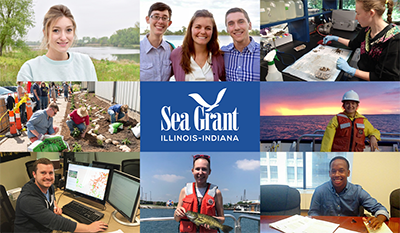 design and implementation to invasive species outreach, youth education and factsheet and video development. IISG also collaborated with Shedd Aquarium to support an intern whose summer project focused on neglected infrastructure in underserved Chicago neighborhoods.
design and implementation to invasive species outreach, youth education and factsheet and video development. IISG also collaborated with Shedd Aquarium to support an intern whose summer project focused on neglected infrastructure in underserved Chicago neighborhoods.
Host Stuart Carlton and the Teach Me About the Great Lakes podcast were featured in an article on the website of Great Lakes Now.
View a list of IISG-funded 2022 research projects.
Publications from the Coastal & Great Lakes Social Science Lab:
- Drivers of revitalization in Great Lakes coastal communities. Rebecca Nixon, Stuart Carlton and Zhao Ma in Journal of Great Lakes Research 2022. 48(6): 1387--1400.
- Aquaculture extension capacity in the Midwest: Results of a survey. Stuart Carlton, Amy Shambach, and Kwamena Quagrainie in Journal of Human Sciences & Extension. In press.
- Trust and collaboration connect remediation and restoration to community revitalization. Rebecca Nixon, Stuart Carlton, Zhao Ma in Journal of Landscape and Urban Planning. In press.
Publications from Höök Lab:
- Variability in fish and water hydrogen and oxygen stable isotope values in the nearshore region of a large water body. Carolyn Foley, G.J. Bowen, and Tomas Höök in Journal of Great Lakes Research, 2022. 48: 1239-1247.
- Nearshore fish assemblage dynamics in southern Lake Michigan: 1984-2016. Christopher Malinowski, J.C. Doll and Tomas Höök in Journal of Great Lakes Researchh, 2022, 48: 1067-1078.
- Spatio-temporal trends in the density and condition of a secondary consumer, Bythotrephes, in southern Lake Michigan. Margaret Stadig, Tomas Höök, Samuel Guffey, E.S. Rutherford, Paris Collingsworth in Journal of Great Lakes Research, 2022. 48: 1121-1127.
- Variation of cisco egg size among Laurentian Great Lakes populations. Scott Koenigbauer, D.L. Yule, K. Dey, C. Olds, M.J. Connerton, and Tomas Höök in Journal of Great Lakes Research, 2022.48:790-797.
- An Evaluation of Fish Spawning on Degraded and Remnant Reefs in Saginaw Bay, Lake Huron. Nicholas Kalejs, Mitch Zischke, Jay Beugly, Paris Collingsworth, E.F. Roseman, R.D. Hunter, D.G. Fielder, and Tomas Höök in Journal of Great Lakes Research, 2022, 48:593-605.
- Nutrient loading effects on fish habitat quality: Trade-offs between enhanced production and hypoxia in Lake Erie, North America. Zoe Almeida, Timothy Sesterhenn, D.K. Rucinski and Tomas Höök in Freshwater Biology, 2022, 67:784-800.
- Widespread prevalence of hypoxia and the classification of hypoxic conditions in the Laurentian Great Lakes.Joshua Tellier, Nicholas Kalejs, Benjamin Leonhardt, D. Cannon, Tomas Höök and Paris Collingsworth in Journal of Great Lakes Research, 2022, 48: 13-23.
- Temporal Variation in the Niche Partitioning of Lake Michigan Salmonines as it Relates to Alewife Abundance and Size Structure. B. Turschak, C. Bronte, S. Czesny, B. Gerig, A. Happel, Tomas Höök, M. Kornis, Benjamin Leonhardt, B. Matthias, J. Rinchard, D. Warner, and H. Boostma in Canadian Journal of Fisheries and Aquatic Sciences, 2022, 79:487-502.
Integrated Deer Management Project (IDMP)
- PI: Dr. Rob Swihart
- The goal of the Integrated Deer Management Project is to combine deer population and habitat condition information with public perceptions of deer and deer management to better inform white-tailed deer management in Indiana.
- Indiana DNR 2021 White-Tailed Deer Report – p120-211
In our third year, we concluded data collection pertaining to deer density, impacts on vegetation, and stakeholder perceptions in three multi-county Regional Management Units (RMUs). This data was supplemented with data on predator populations and stump sprout performance. Analysis of data is in full swing, and results are being shared with a diverse array of stakeholders to improve wildlife management generally and management of Indiana deer specifically.
Deer population density was estimated using distance sampling. Aerial surveys, remotely triggered cameras and ground based surveys were utilized. Zack Delisle, who successfully defended his PhD dissertation in January 2023, and collaborators from IDMP showed that detection of deer from aircraft can be improved by using two types of sensors: an infrared sensor to highlight heat images, and a visible-light camera to verify the identity of the heat source. Aerial estimation of deer density is more cost-effective than other possible approaches and should prove useful to agencies seeking to monitor populations of large species in temperate regions.
and ground based surveys were utilized. Zack Delisle, who successfully defended his PhD dissertation in January 2023, and collaborators from IDMP showed that detection of deer from aircraft can be improved by using two types of sensors: an infrared sensor to highlight heat images, and a visible-light camera to verify the identity of the heat source. Aerial estimation of deer density is more cost-effective than other possible approaches and should prove useful to agencies seeking to monitor populations of large species in temperate regions.
Four methods were compared to assess deer impacts on vegetation at selected woodlots within each RMU. Overstory, midstory, and understory sampling was conducted to determine whether plant communities and deer browsing differed with deer use and landscape characteristics.
Existing perceptions, beliefs, attitudes, and emotions of Indiana residents related to deer and deer management were assessed with 59 semi-structured interviews conducted around the state and two focus groups in Bloomington. These results informed development of a quantitative survey distributed to 6,000 residents across the state. 2022 PhD alumna Taylor Stinchcomb published her qualitative study titled “Complex human-deer interactions challenge conventional management approaches: the need to consider power, trust and emotion” in Ecology and Society.
Publications
- Density from pellet groups: Comparing methods for estimating dung persistence time. Zackary Delisle, Rob Swihart, Brandon Quinby, R.D. Sample, Kevin Kinser-McBee, Emily Tauber, and Elizabeth Flaherty in Wildlife Society Bulletin 2022, 46:e1325.
- Comparing methods of estimating fecal-pellet-group density in woodlots of the Midwestern United States. R.D. Sample, Rylee Tomey, Zackary Delisle, Alexis Trumbower, Phoebe Habeck, Jarred Brooke, and Mike Jenkins in Journal of Fish and Wildlife Management, 2022, 13(2):483-493.

- Changes in white-tailed deer browsing selection of hardwood tree species with increasing stem height. R.D. Sample, Chris Orpurt, Phoebe Habeck, Jameson Pierce, Manoj Ghaste, Joshua Widhalm, Elizabeth Flaherty and Mike Jenkins in Natural Areas Journal, 2022, 42(4):268-277.
- Stump sprouting performance of common tree species in the midstory of hardwood forests in Indiana. R.D. Sample, C. Moriah Boggess, Jarred Brooke and Mike Jenkins in Forest Science, 2022, 68(5-6):440-446.
- Expanding and evaluating public satisfaction with wildlife governance: insights from deer management in Indiana, USA. Taylor Stinchcomb, Zhao Ma, Rob Swihart, and Joe Caudell in Environmental Management, 2022, 70(5):780-792.
- Complex human-deer interactions challenge conventional management approaches: the need to consider power, trust, and emotion. Taylor Stinchcomb, Zhao Ma, and Zoe Nyssa in Ecology & Society 2022, 27(1):13.
Tropical Hardwood Tree Improvement and Regeneration Center
- Director: Dr. Doug Jacobs
- Formed in 2010, the Tropical HTIRC’s mission is to advance the science and application of tree improvement, management, and protection to improve tropical hardwood forests, with emphasis on the Hawaiian Islands. The Tropical HTIRC aims to: improve the genetic quality of tropical hardwoods; develop advanced nursery propagation and seed production technologies; establish a system of native species research and demonstration trials; educate future leaders and engage its stakeholders and address their needs.
- 2022 Annual Report
- 2022-2026 Strategic Plan
In 2022, TropHTIRC began to implement our 2022- 2026 strategic plan, which outlines our strategic objectives over the next five years in research/development.
In 2022, we finally moved beyond the COVID-19 pandemic and held our 2022 Tropical HTIRC Annual Advisory Committee meeting in March in Kealakekua. For many, this was our first in-person meeting in two years and it was a special feeling to be back together again. Our meeting was complemented as usual by a full-day field tour, also at Hāloa ʻĀina – visiting the nursery, field management, and ‘iliahi production facilities. We also added several new members to our Tropical HTIRC Steering / Advisory Committee in 2022, including Jennifer Grimm (Forest Manager, DLNR Division of Fish and Wildlife), Jessica Gurevitch (Department Head, FNR Purdue), and Ania Wieczorek (Interim Dean, College of Tropical Agriculture and Human Resources, University of Hawai’i at Manoa). The Tropical HTIRC Advisory Committee met in Hilo on Jan. 25, 2023.
Many of our projects continue to revolve around koa, a keystone Hawai‘i native forest canopy tree, but we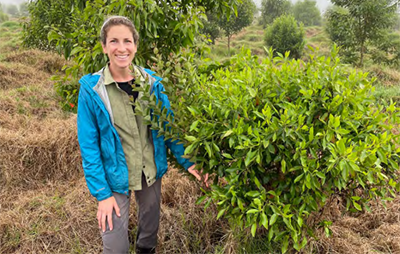 are increasingly focusing on ‘iliahi and ʻōhiʻa to help meet the diverse needs of Hawai’i reforestation and restoration. These projects are being led by our largest team yet of undergraduate / graduate students and post-doctoral scientists at Purdue and University of Hawai‘i at Mānoa, in direct collaboration with Tropical HTIRC partners.
are increasingly focusing on ‘iliahi and ʻōhiʻa to help meet the diverse needs of Hawai’i reforestation and restoration. These projects are being led by our largest team yet of undergraduate / graduate students and post-doctoral scientists at Purdue and University of Hawai‘i at Mānoa, in direct collaboration with Tropical HTIRC partners.
At the January annual meeting, research updates were presented on:ʻŌhiʻa disease resistance program; ʻŌhiʻa carbon and disease resistance; chemical ecology of rapid ʻŌhiʻa death (ROD) spread; ‘iliahi biology, ecology and management; ‘iliahi seedling nutrition and hosts; ‘iliahi stocktypes; ‘iliahi field host suitability; ‘iliahi underplanting and three-pot trial; ‘iliahi-host interactions; ‘iliahi site suitability; ‘iliahi population genetics; Koa cold tolerance; Koa grafting; Koa site preparation and fertilization; Gorse conversion to Koa; Pacific Islands nursery technology assistance, forest restoration and habitat; Community-based forest management; and Genetic diversity of Hawaiian sandalwoods
Partner updates were provided by the Akaka Foundation for Tropical Forests, Hawai’i Department of Land and Natural Resources’ Division of Forestry and Wildlife, Forest Solutions Inc., Hāloa ʻĀina, Hawai’i Agriculture Research Center, Kealakekua Mountain Reserve, National Parks Service, Natural Resources Conservation Service, Paniolo Tonewoods, Parker Ranch, Purdue, U.S. Forest Service Pacific Southwest Research Station’s Institute of Pacific Islands Forestry, and the University of Hawaii.
Tropical HTIRC announced new researchers: Purdue PhD students Erin Bell, Kelly French and Tawn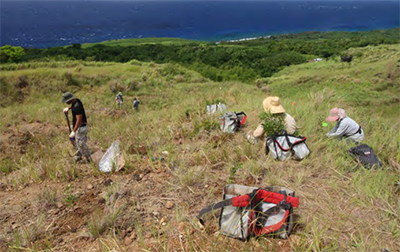 Speetjens (completed MS in December 2022), and University of Hawaii PhD students Solomon Champion, Quinn Moon and Pandu Wirabuana and master’s in environmental management student Aaron Wehrman.
Speetjens (completed MS in December 2022), and University of Hawaii PhD students Solomon Champion, Quinn Moon and Pandu Wirabuana and master’s in environmental management student Aaron Wehrman.
Tropical HTIRC’s extension/outreach program consists of regular field days, workshops, symposia, and development of publications relevant to managers.
Current Research projects
- Koa Cold Tolerance– Aziz Ebrahimi, formerly a PhD student at Purdue and now a post-doc, is evaluating the level of koa’s cold tolerance. Aziz’s study has continued to focus on: 1) the level of cold hardiness through whole-plant physiology analysis, 2) genetic diversity across the elevation cline using cold-hardy genes with Wide-seq sequencing methods.
- Koa Grafting - In summer of 2018, a grafting study collaboration with Kyle Rose, Owen Burney, and Simon Landhäusser was conducted at the New Mexico State University’s JTH Forestry Research Center to examine how different grafting methods (whip-tongue, mechanical V, and non-grafted control) and contrasting seed sources (Umikoa, wet; Kona Hema, dry) influence grafting union success, plant growth, and plant hydraulics. Overall, seed source did not play a significant role on the survival and growth of grafted seedling which was evident from the lack of a significant interaction between seed source and grafting method. When examining the grafting methods, survival of grafted koa seedlings averaged approximately 50% across all methods compared to 95% survival for the non-grafted control seedlings
- Koa Restoration in Gorse-Dominated Landscapes - A study led by Aaron Wehrman was put in place to set 20 Hobo MX2202 sensors in the gorse rows. These sensors take data once per minute between December and March to see whether or not the sensors in the rows of gorse are warmer than their counterparts placed in the open. Should the rows produce warmer temperatures, this method of crushing rows could be replicated on a large scale to reforest koa. If the sensors show sub-freezing temperatures, then precautions will need to be taken for future koa seedlings to avoid frost damage.
- Exploring Pathways and Opportunities for Community-Based Forest Management in Hawai’i–
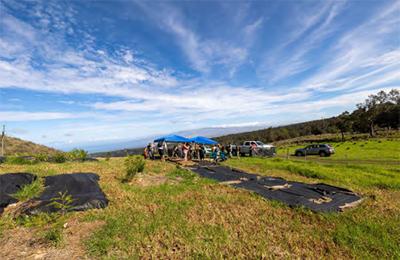 Rebekah Ohara, a PhD student at Purdue, is exploring the potential for the successful implementation of community-based forests in Hawai’i. Ohara’s research aims to answer: How is community-based natural resource management of forests emerging in the Pacific Islands? 2. How can the lessons learned from international and local collaboratively managed forests and community-based subsistence fishing areas be applied to the development of community-managed forests in Hawai‘i? 3. What are the opportunities for the development of community-managed forests in Hawai‘i? How do these opportunities differ depending on land tenure? and 4. How is community-based natural resource management emerging in Hawai‘i?
Rebekah Ohara, a PhD student at Purdue, is exploring the potential for the successful implementation of community-based forests in Hawai’i. Ohara’s research aims to answer: How is community-based natural resource management of forests emerging in the Pacific Islands? 2. How can the lessons learned from international and local collaboratively managed forests and community-based subsistence fishing areas be applied to the development of community-managed forests in Hawai‘i? 3. What are the opportunities for the development of community-managed forests in Hawai‘i? How do these opportunities differ depending on land tenure? and 4. How is community-based natural resource management emerging in Hawai‘i? - ‘Iliahi biology, ecology and management - While the recent burgeoning interest in growing ʻIliahi for restoration and commercial forestry is an exciting development, in order to transition from interest to successful implementation, major steps towards understanding ʻiliahi cultivation systems are required. The development of cultivation systems tailored to Hawaiʻi’s unique environment is vital to the success of ʻiliahi restoration and commercial sandalwood forestry operations. Emily Thyroff has maintained an experiment began by Dr. Kyle Rose in 2019 with regular seedling survival and morphology measurements. Thyroff has designed and implemented a set of greenhouse and field experiments to better understand relationships between ‘iliahi and co-occurring native forest tree species.
Tawn Speetjens has been working to understand and develop the systems required to grow ‘iliahi in Hawai‘i during his past four years working for the Hāloa ‘Āina reforestation project. He has experimented with various strategies to grow healthy ‘iliahi seedlings and has unearthed several findings that have helped to direct his research while at Purdue University. The results have shown that nursery fertilization had the greatest effect on field planting S. paniculatum and enhanced survival, height, height growth, root collar, and root collar growth.
- Genetic Diversity of Hawaiian Sandalwoods - As part of his PhD research in the Botany Department at the University of Hawai‘i at Mānoa, Solomon Champion is studying the genetics of native Hawaiian sandalwood. Fifteen putative populations of Santalum paniculatum from around Hawai’i Island have been analyzed here to ascertain relatedness and potential gene flow between them.
- ʻŌhiʻa Disease Resistance Program - The ʻŌhiʻa Disease Resistance Program (ʻŌDRP), a multi-partner initiative of federal, state, and university entities, and led by the Akaka Foundation for Tropical Forests, supports the disease resistance needs of ʻōhiʻa, including identifying ROD-resistant plants vital to the restoration of forest areas impacted by ROD. Our goal is to support private landowners and conservation land managers who want to perpetuate ʻōhiʻa across their lands.
Two full time staff members – greenhouse operations coordinator Ryan Belcher and greenhouse and field specialist Nainoa Goo – were hired to work closely with collaborates to support and expand the research efforts of the ʻŌDRP.
The ʻŌDRP concluded our first disease resistance screening trial, which ran for eight months from October 2021 through June 2022. Over the next year, we will continue to grow and screen ʻōhiʻa seedlings from across the state. We will continue to work with the ʻŌDRP advisory committee to optimize growth and production of ʻōhiʻa plants for ʻŌDRP research, and develop efficient inoculation methods with the goal of also improving the accuracy of our inoculation-based test. And, we will outplant potentially resistant individuals from initial 2016-2017 efforts and the first ʻŌDRP disease resistance screening trial, while initiating our field-testing phase, both of which will put us closer to identifying ʻōhiʻa resistant to C. lukuohia.
- Chemical ecology of rapid ʻŌhiʻa death (ROD) spread- Understanding the role of insects in the spread
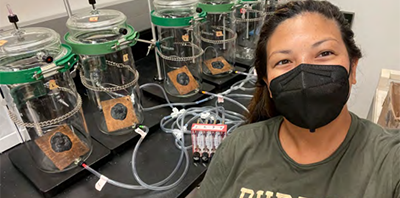 of the fungal disease, Rapid ‘Ōhiʻa Death (ROD), has been a main focus for Kylle Roy prior to beginning her PhD work at Purdue. Her research has found that similar to other Ceratocystis diseases, ROD is associated with wounds and ambrosia beetles. Given the role of these beetle species in the spread of ROD, there is a critical need to develop ambrosia beetle management strategies to mitigate the spread of ROD and protect the Hawaiian rainforest and watershed. Kylle’s PhD work encompasses different aspects of understanding how ‘ōhiʻa trees, ROD-causing fungi (C. lukuohia and C. huliohia), and Xyleborini ambrosia beetles communicate, with the long-term goal of developing management strategies to prevent the spread of ROD.
of the fungal disease, Rapid ‘Ōhiʻa Death (ROD), has been a main focus for Kylle Roy prior to beginning her PhD work at Purdue. Her research has found that similar to other Ceratocystis diseases, ROD is associated with wounds and ambrosia beetles. Given the role of these beetle species in the spread of ROD, there is a critical need to develop ambrosia beetle management strategies to mitigate the spread of ROD and protect the Hawaiian rainforest and watershed. Kylle’s PhD work encompasses different aspects of understanding how ‘ōhiʻa trees, ROD-causing fungi (C. lukuohia and C. huliohia), and Xyleborini ambrosia beetles communicate, with the long-term goal of developing management strategies to prevent the spread of ROD.

